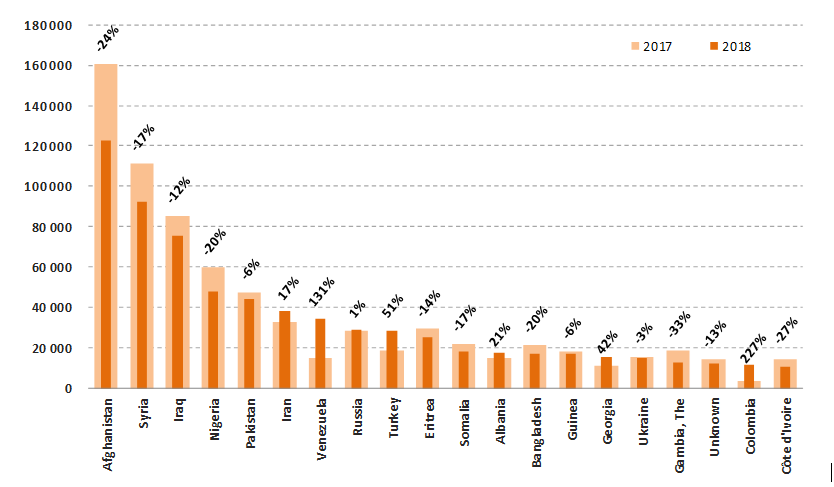The top five nationalities of asylum applicants awaiting a final decision remained the same as in 2017 (Figure 25) but for each of these nationalities the stock decreased. Applications by Afghans, Syrians, Iraqis, Nigerians and Pakistanis represented 43 % of the stock at the EU+ level. Close to 1 in 7 applicants awaiting a decision was a citizen of Afghanistan, about 1 in 10 was a Syrian and 1 in 12 was an Iraqi national. About four fifths of the Afghan applications were pending in Germany (56 %), Austria (13 %) and Greece (11 %). Some 62 % of the Syrian and 58 % of the Iraqi pending cases were in Germany. Nigerians were awaiting a final decision predominantly in Germany (46 %) and Italy (37 %). The largest stocks for Pakistani applicants were in Germany (32 %), Italy (26 %) and Greece (24 %).
Figure 25 displays the changes in the stocks for the top 20 citizenships of applicants awaiting a decision at the end of 2018 compared to the stock at the end of 2017. Despite the overall decreasing trend and the notable reductions in the level of pending cases for the top nationalities, the stock rose for applicants from several countries of origin. The most considerable relative increases appeared for Colombian and Venezuelan citizens. The latter were also subject to the largest absolute increase. The pending cases of Colombians more than tripled (+ 227 %) compared to the end of 2017 and for Venezuelans the stock more than doubled (+ 131 %). About 9 in 10 Colombian and Venezuelan nationals were awaiting a decision in Spain. Furthermore, important increases in the number of pending cases were recorded for applicants from Turkey (+ 51 %), Georgia (+ 42 %), Albania (+ 21 %) and Iran (+ 17 %). The majority of the Iranian and Turkish applicants awaiting a decision had applied in Germany. For Albanians and Georgians, the bulk of the stock was distributed among several receiving countries. Beyond the top 20 citizenships, noteworthy absolute increases in the number of pending cases occurred also for applicants from Palestine, El Salvador, Honduras, and Nicaragua.
|
Pending cases, by citizenship and year |
 |
|
Figure 25: At the end of 2018 the number of pending cases decreased for the citizenships with the largest stocks but increased for applicants from several other countries |

